Common Admission Test (CAT 2004)
Section - I
Sub-Section I – A: Number of Questions = 26
Ans .
1
- Explanation :
GPA of Preeti = 3.2
i.e.,\( \frac{F+D+x+D+y}{5} \)=3.2
⇒ 0 + 2 + x + 2 + y = 16
⇒ x + y = 12
The only possible combination is A, A.
Hence, Preeti obtained A grade in Statistics.
Ans .
4
- Explanation :
Total points scored by Tara = 2.4 × 5 = 12
She scored same grade in three of the subjects, so her score is of the form 3x + y + z = 12
She cannot have scored 3 A’s as her total points will exceed 12.
She can score 3 B’s and 2 F’s which will make her total points 3 × 4 + 2 × 0 = 12.
She cannot score 3 C’s as the points in remaining two will be 12 – 3 × 3 = 3 and only possible breakup is (3,0). This will contradict the fact that she had same grade in only three courses.
For a similar reason, she cannot score 3 D’s.
She cannot score 3 F’s, because for the remaining two courses she has to amass 12 points which is possible if she score A in both – a contradiction.
Hence, Tara could have scored a B or F grade in Operations
Ans .
2
- Explanation :
GPA of Gowri is 3.8 i.e. 3 + 3 + 6 + x + 4 = 3.8 × 5
16 + x = 19
x = 3
So in Strategy, Gowri's grade is C.
Rahul's grade in strategy = (4.2 × 5) – 15 = 6, i.e., A.
Fazal's grade in strategy = (2.4 × 5) – 8 = 4, i.e., B.
Hence, Gowri's grade will be higher than that of Hari.
Ans .
3
- Explanation :
As Fazal’s GPA = 2.4
So D + F + B + X + D = 2.4 × 5
⇒ 2 + 0 + 4 + X + 2 = 12
⇒ X = 4
So his grade in Strategy is B.
So grade of Utkarsh in Marketing is also B.
So for Utkarsh, Y + B + F + C + A = 3 × 5
⇒ Y + 4 + 0 + 3 + 6 = 15
⇒ Y = 2
So grade of Utkarsh in Finance = D.
Ans .
3
- Explanation :
Average incomes of
Ahuja family=\( \frac{3200+3000 +2800}{3}=\frac{9000}{3}=3000; \)
Bose family=\( \frac{2300+2100+2800}{3}=\frac{7200}{3}=2400; \)
Coomar family=\( \frac{1200+2200+1600}{3}=\frac{5000}{3}\approx1667; \)
and Dubey family =\( \frac{1200+3200}{2}=\frac{4400}{3}=2200. \)
Hence, Coomar family has the lowest average income.
Ans .
4
- Explanation :
The average expenditures (approximately) for the families:
Ahuja = \( \frac{700+1700+2700}{3}\approx1733; \)
Bose = \( \frac{800+1750+2300}{3}\approx1617; \)
Coomar = \( \frac{500+1100+1900}{3}\approx1167; \) and
Dubey = \( \frac{1200+2800}{2}=2000. \)
Hence, Dubey family has the highest average expenditure.
Ans .
4
- Explanation :
The average savings (approximately) for the families:
Ahuja = \( \frac{2500+1300+100}{3}=1300; \)
Bose = \( \frac{1500+350+500}{3}≈783; \)
Coomar = \( \frac{700+1100+300}{3}=700 \) and
Dubey = \( \frac{0+400}{2}=200. \)
Hence, Dubey family has the lowest average savings.
Ans .
1
- Explanation :
The savings of a person is maximum if he/she has high income but less expenditure. From the graph, a member of Ahuja family has Rs.3200 as income and Rs.700 as expenditure. Hence, he/she will have the maximum savings among all.
Ans .
1
- Explanation :
On day 3, there were 2 visitors from UK and 1 from USA. On the same day, the site was visited by 2 persons from University 4 and 1 from University 6. So University 4 is located in UK and University 6 is in USA.
Similar reasoning for day 2 gives us the conclusion that University 3 is located in Netherlands and University 8 is in India.On day 1, the number of visitors from USA is 1 and that from University 6 is 1. University 6 is in USA (derived above), which implies no other university is in USA.
The number of visitors from India on day 1 is 1. Also, no visitor from University 8, which is in India has visited the site on day 1. This implies that one of University 1 and University 5 is in India and the other in Netherlands. A similar logic gives us that one of University 2 and University 6 is in UK and the other in Canada.
Ans .
3
- Explanation :
Same as 9
Ans .
1
- Explanation :
Same as 9
Ans .
2
- Explanation :
Same as 9
Ans .
2
- Explanation :
Number of Naya mixer-grinders disposed off in 1999
= 20% of 30 = 6 So the number of Naya mixer-grinders in 1999, i.e. 124 is inclusive of those mixer grinders produced in 1997 and 1998 and still in operation. The numbers are (30 – 6)= 24 and (80 – 30) = 50 respectively. Therefore, number of new Naya mixer-grinders purchased in 1999 = 124 – (50 + 24) = 50.
Ans .
2
- Explanation :
Number of Naya mixer-grinders disposed off in 1999
= 20% of 30 = 6 Number of Naya mixer-grinders disposed off in 2000
= 20% of (80 – 30) = 10 Therefore, total number of Naya mixer-grinders disposed by end of 2000 = 6 + 10 = 16.
Ans .
4
- Explanation :
Sine information regarding the number of Purana mixer-grinders for the years prior to 1995 is not known, it cannot be ascertained as to how many of them were disposed off in 2000.
Ans .
1
- Explanation :
It is given that 10 Purana mixer-grinders were disposed off as junk in 1997. So the number of mixer-grinders in operation in 1997 must have been 162 – 10 = 152. But it is given to be 182.
∴ Number of newly purchased Purana mixergrinder in 1997 = 182 – 152 = 30
20% of this, i.e. 6 were disposed off in 1999. So the number of mixer-grinders in operation in 1999 must have been 222 – 6 = 216. But it is given to be 236.
∴ Number of newly purchased Purana mixergrinder in 1999 = 236 – 216 = 20.
Ans .
4
- Explanation :
Thailand and Japan (Maximum difference of 4 ranks (5 – 1) = 4).
Ans .
1
- Explanation :
China (Maximum difference of 2 between 2 parameter’s 2)
Ans .
2
- Explanation :
Japan (Maximum difference of 4.)
Ans .
4
- Explanation :
Japan and Malaysia (Inferring from question 17)
Ans .
1
- Explanation :
Let incomes of Zakib and Supriyo be Z and S respectively.
Statement A: 20% of Z > 25% of S
⇒ Z > \( \frac{5}{4}\)S
Now, Zakib spent 30% of his income on education = 30% of Z > \( \frac{30}{100} × \frac{5}{4}\)S = 0.375S
From this we cannot say if 0.3 Z is greater than or less than 0.4 S.
Hence, statement A alone is not sufficient.
Statement B: 13% of S > 10% of Z
Multiplying both sides by 3, we get, 39% of S > 30 % of Z
So 40% of S is definitely more than 30% of Z.
Hence, statement B alone is sufficient.
Ans .
1
- Explanation :
Assume A, B, C, D gets score 10, 8, 6, 4 respectively.
A B C D
10 8 6 4
Statement A:
With the conditions, A will give vote to B
With the conditions, B will give vote to A
With the conditions, C will give vote to A
Even if D gives to A/B/C - 2 situation arises.
Either A will win or there will a tie when D gives vote to B.
Even then A will win.
So we are getting the answer.
Statement B: Nothing concrete can be derived.
Ans .
1
- Explanation :
Statement A: Nothing can be said.
Statement B: Since there are 3 boys in the top 5 rank holders, the other two are girls and Rashmi is not one of them. As Kumar is ranked sixth, Rashmi is either seventh or below. Hence, statement II alone is sufficient.
Ans .
2
- Explanation :
 Statement A: To reach the Red mark, Tarak needs to take even number of steps and to reach the Blue
mark, he needs to take odd number of steps. Given that the number of steps taken by him is 21. Therefore,
Tarak stops at the Blue mark.
Statement A: To reach the Red mark, Tarak needs to take even number of steps and to reach the Blue
mark, he needs to take odd number of steps. Given that the number of steps taken by him is 21. Therefore,
Tarak stops at the Blue mark.
Hence, statement A alone is sufficient.
Statement B: If the number of tails is 3 more than the heads, then the effective movement will be 3 steps to the left, i.e. Tarak will reach Blue mark.
Hence, statement B alone is sufficient.
Ans .
3
- Explanation :
Statement A: 2 kg potato cost + 1 kg gourd cost < 1 kg potato cost + 1 kg gourd cost
⇒ 1 kg potato cost < 1 kg gourd cost.
Hence, statement A is not sufficient.
Statement B: 1 kg potato cost + 2 kg onion cost = 1 kg onion cost + 2 kg gourd cost 1 kg potato cost + 1 kg onion cost = 2 kg gourd cost.
Hence, statement B is also not sufficient.
Combining both statements, we get
1 kg potato cost < 1 kg gourd cost …(i)
1 kg potato cost + 1 kg onion cost = 2 kg gourd cost …(ii)
Hence, onion is the costliest.
Ans .
4
- Explanation :
Statement A: 13 currency notes will give different Values.
Statement B: Multiple of 10 and by many.
Even if you combine the statement, we can have various values.
Answer is (4).
Sub-Section I-B: Number of Questions = 12
Ans .
3
- Explanation :
Go through the following table.
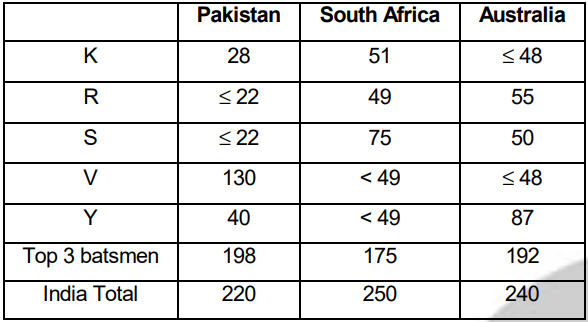
Ans .
1
- Explanation :
Go through the following table.

Ans .
2
- Explanation :
Go through the following table.

Ans .
2
- Explanation :
Go through the following table.

Ans .
4
- Explanation :
For solving these questions make a table like this:
(i) As the labour expert is half of each of the other, so the only possible combination is:
L – 3
H<___|
P |6 each
R<___|
(ii) Statement (d): If the number of Australasia expert is 1 less, i.e. total export are 20 American be twice as each of other. The only combined possible is Americas = 8.
Australasia = 4 + 1 = 5
Europe = 4
Africa = 4
Now, we need to workout the various options possible in the blank cells.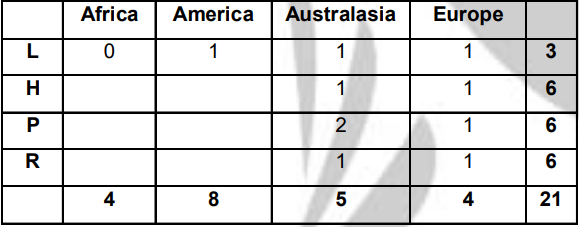
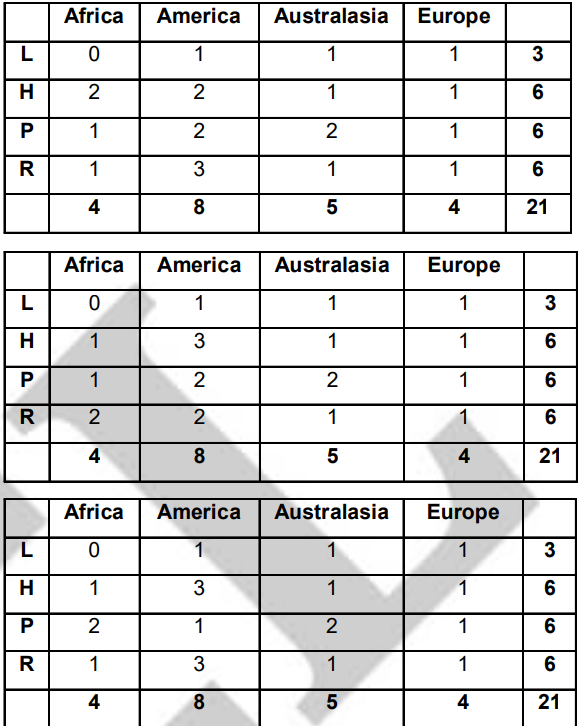
Ans .
3
- Explanation :
Same as 31
Ans .
3
- Explanation :
Same as 31
Ans .
4
- Explanation :
Same as 31
Ans .
4
- Explanation :
Germany has won both their matches, so possible winning combinations in first two rounds is R1 : Won 1 - 0 and R2: Won 2 - 1
Or
R1 : Won 2 - 1 and R2: Won 1 - 0.
Argentina must have won R1 and R2 by 1 - 0.
If Germany won by 2 - 1 in R1 vs Spain, Spain won in R2 by 4 - 0, and if Germany won 1 - 0 in R1, then Spain won 5 - 1 in R2.
Since only New Zealand and South Africa conceded 4 or more than 4 goals, then Spain must have played either one in R2.
If Spain won 4 - 0 in R2 vs South Africa, then South Africa must win R1 by 1 - 0, which is a contradiction to the fact that South Africa has lost both R1 and R2. Also, Spain can never win 5 - 1 vs South Africa in R2 (goals conceded by South Africa is 4).
Therefore, Spain won against New Zealand in R2.
Germany:
R1 vs Spain Won 2 -1 or 1 - 0
R2 vs SA/Pak Won 1 - 0 or 2 - 1
R3 vs Arg Draw
Spain:
R1 vs Germany Lost 1 - 2 or 0 - 1
R2 vs NZ Won 4 - 0 or 5 - 1
R3 vs Pak Draw
New Zealand:
R1 vs Arg/Pak Lost 1 - 2 or 0 - 1
R2 vs Spain Lost 0 - 4 or 1 - 5
R3 vs SA Draw
Looking at the table, the only possible outcomes for Pakistan in the first two rounds are 2 -0 win and 0 - 1 loss.
In R1, New Zealand cannot lose 1 - 2 since Argentina conceded no goals and Pakistan's only loss was by a margin 0 - 1.
Therefore, NZ lost R1 0 - 1. This score is possible only if its opponent is Argentina. Consequently, NZ lost 1 - 5 in R2 vs Spain. Hence, Spain must have lost 0 - 1 to Germany.
The above information can be finally summarised as:
Germany: R1 vs Spain Won 1 - 0
R2 vs SA Won 2 - 1
R3 vs Arg Draw
Spain: R1 vs Germany Lost 0 - 1
R2 vs NZ Won 5 - 1
R3 vs Pak Draw
New Zealand: R1 vs Arg Lost 0 - 1
R2 vs Spain Lost 1 - 5
R3 vs SA Draw
Pakistan: R1 vs SA Won 2 - 0
R2 vs Arg Lost 0 - 1
R3 vs Spain Draw
Argentina: R1 vs NZ Won 1 - 0
R2 vs Pak Won 1 - 0
R3 vs Germany Draw
South Africa: R1 vs Pak Lost 0 - 2
R2 vs Germany Lost 1 - 2
R3 vs NZ Draw
Ans .
2
- Explanation :
Same as 35
Ans .
4
- Explanation :
Same as 35
Additional information for Q.37:
* The given data set for rounds 4 and 5 appears to be inconsistent because from statements (a), (b) and (c) it is evident that four teams namely Spain, Argentina, Germany and Pakistan won their fifth round matches whereas the maximum possible wins in any round is only 3.
Ans .
4
- Explanation :
Same as 35
Additional information for Q.38:
* The given data set for rounds 4 and 5 appears to be inconsistent because from statements (a), (b) and (c) it is evident that four teams namely Spain, Argentina, Germany and Pakistan won their fifth round matches whereas the maximum possible wins in any round is only 3.
Section - II
Sub-Section II-A: Number of questions = 20
Ans .
3
- Explanation :
The boats will be colliding after a time which is given by
\( t = \frac{20 + 5}{10} = \frac{4}{3} \) hours 80 minutes
After this time of 80 minutes, boat (1) has covered
\( 80×\frac{5}{60}kms = \frac{20}{3}kms \), whereas boat (2) has covered
\( 80×\frac{10}{60}kms = \frac{40}{3}kms \).
After 79 minutes, distance covered by the first boat = \( d_{1} =\left( \frac{20}{3} - \frac{5}{60} \right)kms \)
After 79 minutes, distance covered by the second boat = \( d_{2} =\left( \frac{40}{3} - \frac{10}{60} \right)kms \)
So the separation between the two boats
\( 20 -\left( d_{1} + d_{2}\right) = \frac{1}{4}kms \)
Alternative method:
Relative speed of two boats = 5 + 10 = 15 km/hr
i.e. in 60 min they cover (together) = 15 km
∴ in 1 min they will cover (together) \( \frac{15}{60} \) = \( \frac{1}{4} km \)
Ans .
2
- Explanation :
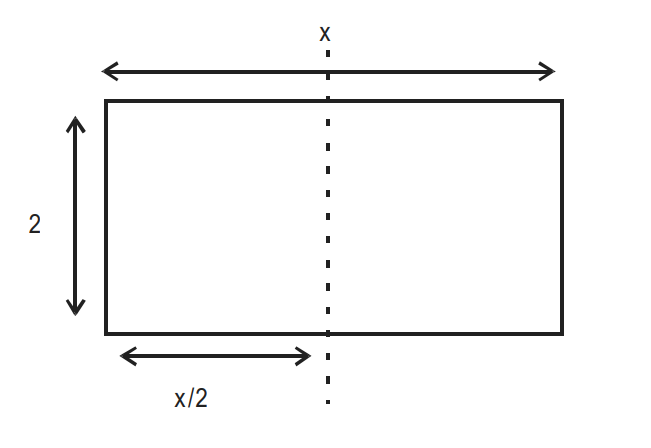 In original rectangle ratio = \( \frac{x}{2} \)
In original rectangle ratio = \( \frac{x}{2} \)
In smaller rectangle ratio = \( \frac{2}{ \left( \frac{x}{2} \right) } \)
Given \( \frac{x}{2} = \frac{2}{ \frac{x}{2} } ⇒ x = 2\sqrt{2} \)
Area of smaller rectangle \( = \frac{x}{2}×2 = x = 2\sqrt{2} \) sq. units.
Ans .
1
- Explanation :
Given
\( t_{1} + t_{2} ... t_{11} = t_{1} + t_{2} ... t_{19} \) ( for an A.P.)
⇒\( \frac{11}{2} \)[2a + (11 - 1)d] = \( \frac{19}{2} \)[2a + (19 - 1)d]
⇒ 22a + 110d = 38a + 342d
⇒ 16a + 232d = 0
⇒ 2a + 29d = 0
⇒\( \frac{30}{2} \)[2a + (30 - 1)d] = 0
⇒ \( S_{30terms} \) = 0
Ans .
2
- Explanation :
Let d be the distance to be travelled and t be the time taken to reach at 1 p.m.
If the man cycles at 10 km/hr, then \( \frac{d}{t} = 10 \) .....(i)
If the man cycles at 15 km/hr, then \( \frac{d}{t-2} = 15 \) .....(ii)
Solving (i) and (ii), we get t = 6 hours and d = 60 km
To reach the place by noon, he needs to cycle at = \( \frac{d}{t-1} = \frac{60}{6-1} = 12 km/hr \)
Ans .
1
- Explanation :
There will be an increase of 6 times. Number of members \( s_{1} \) will be in A.P.
On July 2nd , 2004, \( s_{1} \) will have n + 6 b members = n + 6 × 10.5 n = 64n
Number of members in \( s_{2} \) will be in G.P
On July 2nd, 2004, number of members in \( s_{2} = nr^{6} \)
They are equal.
Hence, 64 n = \( nr^{6} \)
⇒ 64 = \( r^{6} \) ⇒ r = 2
Ans .
2
- Explanation :
We have
f(0) = \(0^{3}\) – 4(0) + p = p
f(1) = \(1^{3}\) – 4(1) + p = p - 3
If p and p – 3 are of opposite signs, then p(p – 3) < 0
Hence, 0 < p < 3.
Ans .
1
- Explanation :
We have
(a) \( 10^{10} < n < 10^{11} \)
(b) Sum of the digits for 'n' = 2
Clearly,
(n) min = 10000000001 (1 followed by 9 zeros and finally 1)
Obviously, we can form 10 such numbers by shifting '1' by one place from right to left again and again.
Again, there is another possibility for 'n'
n = 20000000000
So number of different values of n = 10 + 1 = 11.
Ans .
1
- Explanation :
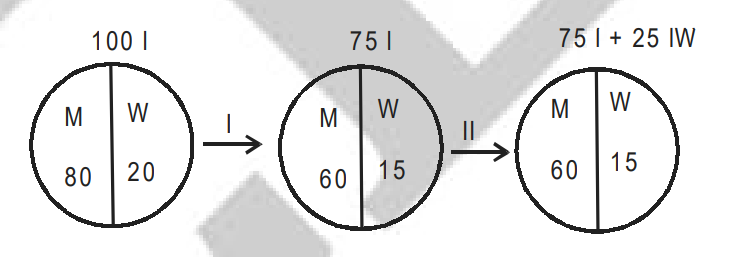 The diagram is self explanatory. Removal of 25 litres at stage I will result in volume of milk being reduced by 80% of 25 lit i.e. 20 lit and volume of water being reduced by the remaining 5 lit.So M = 60 lit and W = 15 lit.Addition of 25 lit water will finally given M = 60 lit and W = 40 M. Hence the ratio of W and M = 40 : 60 = 2 : 3.
The diagram is self explanatory. Removal of 25 litres at stage I will result in volume of milk being reduced by 80% of 25 lit i.e. 20 lit and volume of water being reduced by the remaining 5 lit.So M = 60 lit and W = 15 lit.Addition of 25 lit water will finally given M = 60 lit and W = 40 M. Hence the ratio of W and M = 40 : 60 = 2 : 3.
Ans .
3
- Explanation :
If \( \frac{a}{b + c} = \frac{b}{c + a} = \frac{c}{a + b} = r\)
then there are only two possibilities.
(i) If a + b + c ≠ 0, then
\( \frac{a}{b + c} = \frac{b}{c + a} = \frac{c}{a + b} = \frac{a + b + c}{(b + c)+(c + a)+(a + b)} \)
\( = \frac{a + b + c}{2(a + b + c)} = \frac{1}{2} \)
(ii) If a+ b + c = 0, then
b + c = – a
c + a = – b
a + b = – c
Hence, \( \frac{a}{b + c} = \frac{a}{-a} = -1 \)
Similarly, \( \frac{b}{c + a} = \frac{c}{a + b} = -1 \)
Therefore, option (3) is the correct answer.
Ans .
4
- Explanation :
\( y = \frac{1}{2 + \frac{1}{3 + y}} \)
\( ⇒ y = \frac{3 + y}{7 + 2y} \)
\( ⇒ 2y^{2} + 6y – 3 = 0 \)
\( ⇒ y = \frac{–6 ± \sqrt{36 + 24}}{4} \)
\( = \frac{–6 ± \sqrt{60}}{4} = \frac{–3 ± \sqrt{15}}{2}\)
Since 'y' is a +ve number, therefore:
\( y = \frac{\sqrt{15} - 3}{2} .\)
Ans .
4
- Explanation :
Race 1:
In whatever time Karan covers a distance of 100 m, Arjun covers 90 m in the same time.
∴ Ratio of their speeds = 10 : 9
Race 2:
Now Karan is 10 m behind the starting point. Once again to cover 100 m from this new point Karan will be taking the same time as before. In this time, Arjun will be covering 90 meters only. This means that now both of them will be at the same point, which will be 10 meters away from the finish point. Since both of them are required to cover the same distance of 10 m and Karan has a higher speed, he will beat Arjun. No need for calculations as option (4) is the only such option.
Ans .
2
- Explanation :
Each person will form a pair with all other persons except the two beside him. Hence he will form (n – 3) pairs.
If we consider each person, total pairs = n (n – 3) but here each pair is counted twice.
Hence actual number of pairs \( = \frac{n(n – 3)}{2} \)
They will sing for \( = \frac{n(n – 3)}{2}×2 = n(n – 3) min \)
Hence n(n -3) = 28 \( ⇒ n^{2} – 3n – 28 = 0 ⇒ = n = 7 or – 4\)
Discarding the negative value: n = 7
Ans .
3
- Explanation :
Machine I:
Number of nuts produced in one minute = 100
To produce 1000 nuts time required = 10 min
Cleaning time for nuts = 5 min
Effective time to produce 1000 nuts = 15 min
Effective time to produce 9000 nuts = 15 × 9 – 5 = 130 min
Machine II:
To produce 75 bolts time required = 1 min
To produce 1500 bolts time required = 20 min
Cleaning time for bolts = 10 min
Effective time to produce 1500 bolts = 30 min
Effective time to, produce 9000 bolts = 30 × 6 – 10
= 170 min … (ii)
From (i) and (ii),
Minimum time to produce 900 pairs of nuts and bolts
= 170 minutes
Ans .
4
- Explanation :
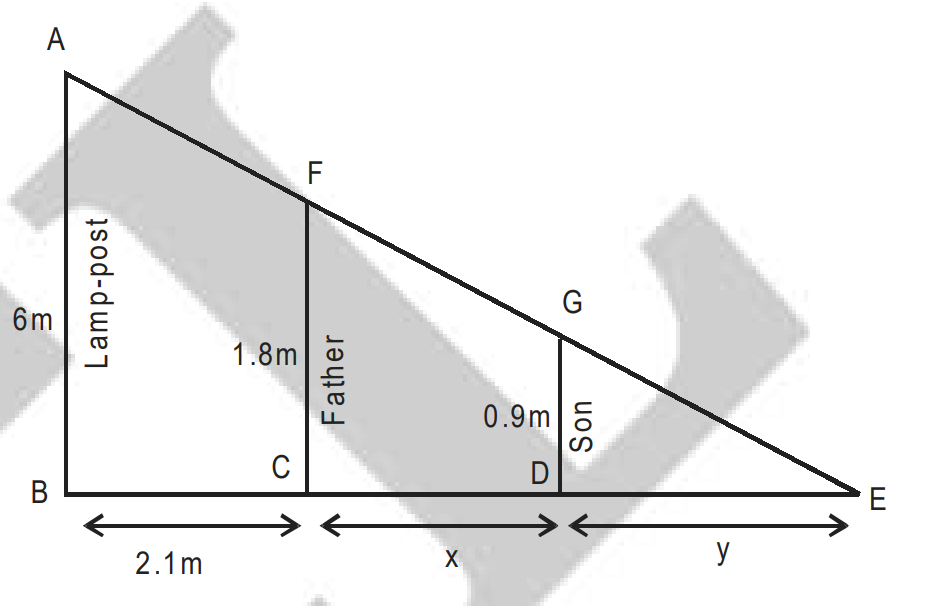 ∆ABE \( \sim \) ∆FCE
∆ABE \( \sim \) ∆FCE
\( ∴ \frac{6}{1.8} = \frac{2.1 + x + y}{x + y} \)…(i)
Also ∆ABE \( \sim \) ∆GDE
\( ∴ \frac{6}{0.9} = \frac{2.1 + x + y}{x + y} \)…(ii)
From (i) and (ii), x = 0.45m.
Ans .
2
- Explanation :
\( \frac{OP}{OQ} = \frac{PR}{QS} = \frac{4}{3} \)
OP = 28
OQ = 21
PQ = OP – OQ = 7
\( \frac{PQ}{OQ} = \frac{7}{21} = \frac{1}{3} \)
Alternative method:
\( \frac{OP}{OQ} = \frac{PR}{QS} = \frac{4}{3} \)
\( ⇒\frac{OP}{OQ} - 1 = \frac{4}{3} - 1 \)
\( ⇒\frac{OP - OQ}{OQ} = \frac{1}{3} ⇒\frac{PQ}{OQ} = \frac{1}{3} \)
Ans .
2
- Explanation :
PR + QS = PQ = 7
\( = \frac{PR}{QS} = \frac{4}{3} \)
⇒ QS = 3 cm
Ans .
3
- Explanation :
\( SO = \sqrt{OQ^{2} – QS^{2}} \)
\( = \sqrt{21^{2} – 3^{2}} \)
\( = \sqrt{24×18} = 12\sqrt{3}cm \)
Ans .
4
- Explanation :
When a > 0, b < 0,
\( ax^{2} \) and –b |x| are non negative for all x,
i.e. \( ax^{2} \) – b|x| ≥ 0
∴ \( ax^{2} \) – b |x| is minimum at x = 0 when a > 0, b < 0.
Ans .
4
- Explanation :
 As per the question, we need to satisfy three
As per the question, we need to satisfy three
conditions namely:
1. Adults (A) > Boys (B)
2. Boys (B) > Girls (G)
3. Girls (G) > Families (F)
Clearly, if the number of families is 2, maximum number of adults can only be 4. Now, for the second condition to be satisfied, every family should have atleast two boys and one girl each. This will result in noncompliance with the first condition because adults will be equal to boys. If we consider the same conditions for 3 families, then all three conditions will be satisfied.
Ans .
3
- Explanation :
Given equation is x + y = xy
⇒ xy – x – y + 1 = 1
⇒ (x – 1)(y – 1) = 1
∴ x – 1 = 1 and y − 1 = 1 or x − 1 = –1 & y – 1 = –1
Clearly, (0, 0) and (2, 2) are the only pairs that will satisfy the equation.
Sub-Section II - B: Number of Questions = 15
Ans .
4
- Explanation :
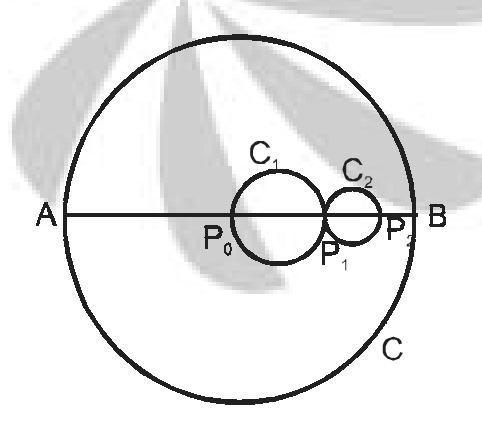 Circle Radius
Circle Radius
C r
\( C_{1} \) \( \frac{r}{4} \)
\( C_{2} \) \( \frac{r}{8} \)
\( C_{3} \) \( \frac{r}{16} \)
\( ⇒ \frac{Area of unshaded portion of C}{Area of C} \)
\( = 1 - \frac{Area of shaded portion 1}{Area of C} \)
\( = 1 - \frac{π\left( \left( \frac{r}{4} \right)^{2} + \left( \frac{r}{8} \right)^{2} + ... \right)} {πr^{2}}\)
\( = 1 - \left( \frac{1}{4^{2}} + \frac{1}{8^{2}} + ... \right) = 1 - \frac{\frac{1}{16}}{1 - \frac{1}{4}} = \frac{11}{12} \)
Ans .
3
- Explanation :
Given \( a_{1} \) = 81.33; \( a_{2} \) = –19
Also:
\( a_{j} \) = \( a_{j} \)–1 – \( a_{j} \)–2 , for j ≥ 3
⇒ \( a_{3} \) = \( a_{2} \) – \( a_{1} \) = –100.33
\( a_{4} \) = \( a_{3} \) – \( a_{2} \) = –81.33
\( a_{5} \) = \( a_{4} \) – \( a_{3} \) = 19
\( a_{6} \) = \( a_{5} \) – \( a_{4} \) = +100.33
\( a_{7} \) = \( a_{6} \) – \( a_{5} \) = +81.33
\( a_{8} \) = \( a_{7} \) – \( a_{6} \) = –19
Clearly, \( a_{7} \) onwards there is a cycle of 6 and the sum of terms in every such cycle = 0.
Therefore, when we add \( a_{1} \), \( a_{2} \), \( a_{3} \), … upto \( a_{6002} \), we will eventually be left with \( a_{1} \) + \( a_{2} \) only i.e. 81.33 – 19 = 62.33.
Ans .
3
- Explanation :
As options are independent of n, let us assume n = 2.
Circumference of the track = 2πr
∴ Time taken for first round = \( \frac{1}{2} \) + 1 + 2 + 4 = 7.5 minutes
and time taken for second round = 8 + 16 + 32 + 64 = 120 minutes
Hence, ratio = \( \frac{120}{7.5} \) = 16 : 1 = 16
Ans .
2
- Explanation :
u = (\(log_{2}x)^{2} – 6log_{2}x + 12 \)
\( x^{u} = 256 \)
Let \( log_{2}x = y ⇒ x = 2^{y} \)
\( x^{u} = 2^{8} ⇒ uy = 8 ⇒ u = \frac{8}{y} \)
\( ∴ \frac{8}{y} = y^{2} - 6y + 12 ⇒ y^{3} - 6y^{2} + 12y − 8 = 0\)
\( ⇒(y - 2)^{3} = 0 ⇒ y = 2\)
\(∴ x = 4, u = 4\)
Ans .
3
- Explanation :
\( f_{1}f_{2} = f_{1}(x)f_{1}(–x) \)
\( f_{1}(–x) =\begin{cases}-x & 0\leq-x\leq1\\1 & -x \geq 1\\0 & otherwise\end{cases} \)
\( = \begin{cases}-x & 0\leq-x\leq1\\1 & x \leq -1\\0 & otherwise\end{cases} \)
\( f_{1}f_{1}(–x) = 0 \forall x \)
\( Similarly, f_{2}f_{3} = –(f_{1}(–x))^{2} ≠ 0 for some x \)
\( f_{2}f_{4} = f_{1}(–x).f_{3}(–x) \)
\( = –f_{1}(–x)f_{2}(–x) \)
\( = –f_{1}(–x)f_{1}(x) = 0 \forall x \)
Ans .
2
- Explanation :
Checking with options:Option (2):
\( f_{3}(–x) = f_{2}(–x)= –f_{1}(x) \)
\( ⇒ f_{1}(x) = –f_{3}(–x) \forall x \)
Ans .
1
- Explanation :
DF, AG and CE are body diagonals of cube.
Let the side of cube is a.
Therefore, body diagonal is \( a\sqrt{3} \)
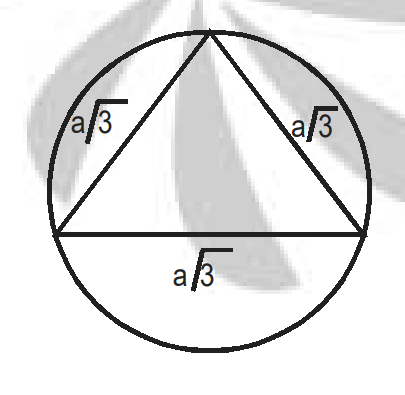 Circum radius for equilateral triangle = \( \frac{Side}{\sqrt{3}} \)
Circum radius for equilateral triangle = \( \frac{Side}{\sqrt{3}} \)
Therefore, \( \frac{a\sqrt{3}}{\sqrt{3}} = a \)
Ans .
2
- Explanation :
From A to B, there are 8 on-way roads out of which 3 roads are in Northwards and 5 roads are Westwards.
Therefore number of distinct routes is \( = \frac{8!}{5!3!} = 56 \)
Ans .
2
- Explanation :
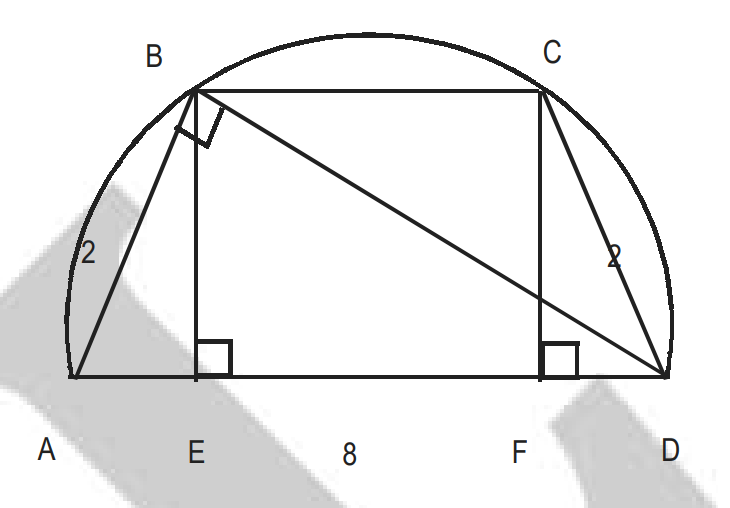 \( \frac{1}{2}×AB×BD = \frac{1}{2}×AD×BE \)
\( \frac{1}{2}×AB×BD = \frac{1}{2}×AD×BE \)
\( ⇒ 2\sqrt{8^{2} − 2^{2}} = 8×BE \)
\( ⇒ BE = \frac{\sqrt{60}}{4} = \frac{\sqrt{15}}{2} \)
\( AE = \sqrt{2^{2} - \left( \frac{\sqrt{15}}{2} \right)^{2}} = \sqrt{4 - \frac{15}{4}} = \frac{1}{2} \)
\( BC = EF = 8 - \left( \frac{1}{2} - \frac{1}{2} \right) = 7\)
Ans .
4
- Explanation :
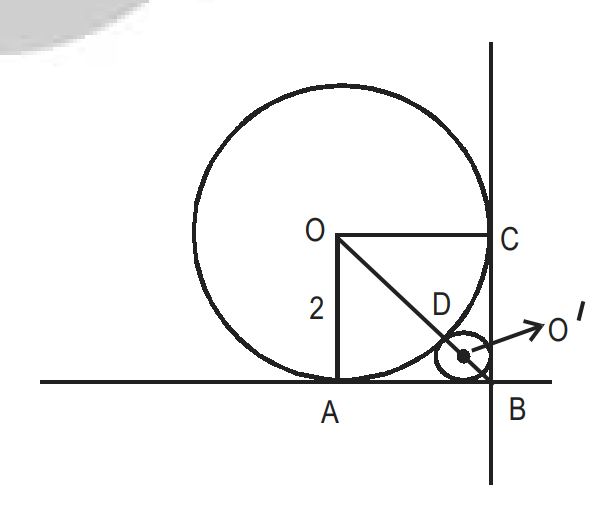 Let the radius of smaller circle be r.
Let the radius of smaller circle be r.
\( ∴ O′B = r\sqrt{2} \)
\( ∴ OB = O′B + O′D + OD \)
\( = r\sqrt{2} + r + 2 \)
\( Also OB = 2\sqrt{2} \)
\( ⇒ r\sqrt{2} + r + 2 = 2\sqrt{2} \)
\( ⇒ r = 6 – 4\sqrt{2} \)
Ans .
4
- Explanation :
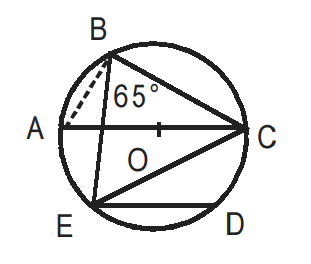 In ∆ABC,
In ∆ABC,
∠B = 90° (Angles in semicircle)
Therefore, ∠ABE = 90 – 65 = 25°
Also, ∠ABE = ∠ACE (Angle subtended by same arc AE)
Also, ∠ACE =∠CED [AC\( \parallel \)ED]
Therefore,∠ CED = 25°
Ans .
1
- Explanation :
Since Group (B) contains 23 questions, the marksassociated with this group are 46.
Now check for option (1). If Group (C ) has onequestion, then marks associated with this group willbe 3. This means that the cumulative marks for thesetwo groups taken together will be 49. Since totalnumber of questions are 100, Group (A) will have 76questions, the corresponding weightage being 76marks. This satisfies all conditions and hence is thecorrect option. It can be easily observed that no otheroption will fit the bill.
Ans .
3
- Explanation :
Since Group (C) contains 8 questions, the corresponding weightage will be 24 marks. This figure should be less than or equal to 20% of the total marks. Check from the options . Option (3) provides 13 or 14 questions in Group (B), with a corresponding weightage of 26 or 28 marks. This means that number of questions in Group (A) will either be 79 or 78 and will satisfy the desired requirement.
Ans .
3
- Explanation :
1523 = (19 – 4)23 = 19x + (–4)23 , where x is a natural number. 2323 = (19 + 4)23 = 19y + (4)23 , where y is a natural number. 1523 + 2323 = 19(x + y) + (4)23 + (–4)23 = 19 (x + y). Hence, remainder will be zero.
Ans .
1
- Explanation :
The first strip can be of any of the four colours, The 2nd can be of any colour except that of the first (i.e. 3). Similarly, each subsequent strip can be of any colour except that of the preceding strip (=3)
Hence number of ways = 4 × 35 = 12 × 81
Section - III
Sub-Section I – A: Number of Questions = 10
Ans .
2
- Explanation :
Ramesh makes a direct, blatant statement that he did not file his income tax returns. Devious means scheming, deceitful.
Ans .
1
- Explanation :
The principal tax is already mentioned as Rs. 20000. He hasn’t filed his income tax returns. Due to the delay he will also have to pay interest on the principal amount.
Ans .
4
- Explanation :
There are no sanctions involved with the income tax. It’s not possible for him to get a refund unless he filesh is returns. Due to the delay he will be charged a fine and not a fee.
Ans .
3
- Explanation :
To impound means to seize property (usually by force of power) and is used normally and here talking about trust fund. So attached here refers to attaching property by legal writ is the best option.
Ans .
2
- Explanation :
Automobiles can only be seized before being auctioned off (and not smashed, dismantled or frozen!).
Ans .
4
- Explanation :
An income tax defaulter is an offender and not a purchaser, victim or investor
Ans .
3
- Explanation :
The words in the previous sentence and the tone of the passage indicate that the corridors were empty.
Ans .
1
- Explanation :
This choice is appropriate because the men were talking in low-pitched voices. Stentorian means marked by loud voice.
Ans .
4
- Explanation :
The word ‘choler’ (which means anger or irritability) in the previous sentence indicates a direct relationship with temper.
Ans .
1
- Explanation :
He couldn’t have strolled the corridors because he was angry. The President would not prowl in the corridors. Also one does not storm a corridor but may storm in and out of a corridor or a room. But one can pace up and down.
Ans .
3
- Explanation :
Sentence B is wrong because efforts ‘bear fruit’ and not ‘give fruit’. Sentence C is incorrect because ‘complimented’ should have been used, complemented means ‘something that completes, makes up a whole’.
Ans .
2
- Explanation :
Sentence B is wrong because you don’t plead ‘guilty of’ but plead ‘guilty to’ a crime. Sentence D is wrong because one gets ‘sentenced to’ prison.
Ans .
1
- Explanation :
Sentence B is incorrect because the correct usage of its last part would be –‘thinking what to do’. Sentence C is wrong because the article ‘a’ should precede ‘shower’.
Ans .
3
- Explanation :
Between options (2) and (3), the difference is in the word advocate and advocating. Both options have the word “incidents”. We need a verb (advocate) and not a gerund (advocating). Hence, the option (3). In option (1), the usage ‘suggest to bring down is incorrect’. In option (4) audiocassette prices ‘should’ be (and not ‘to’ be) brought down. Between options (2) and (3), ‘incidence’ of music piracy can be reduced and not ‘incidents’.
Ans .
3
- Explanation :
Option (2) is incorrect due to the usage of the simple present tense in ‘they portray’. Option (4) is incorrect due to the usage of the singular ‘it’ for the plural ‘things’. Option (1) is wrong because of the unnecessary usage of ‘must have’ after using ‘essential’.
Ans .
4
- Explanation :
Option (2) is incorrect because we cannot say that ‘archeologists ... are estimated’. In option (1), ‘a reasonable certainty’ is incorrect and option (3) has the problems of a misplaced modifier. Hence, option (4) is correct.
Ans .
2
- Explanation :
The correct usage would have been –‘he bolted for the gate’.
Ans .
4
- Explanation :
Fallout does not mean failure. It refers to consequence or argument.
Ans .
2
- Explanation :
The usage of ‘passing her ’ is inappropriate, one can simply say ’passing on the road ‘ or ‘ passing by ‘.
Ans .
1
- Explanation :
AC is a mandatory pair and DAC is a mandatory sequence.
Ans .
2
- Explanation :
B is the opening statement as it introduces the subject and the date. EDA is a sequence that describes the situation from the east to the west. Statement C is a stand-alone statement.
Ans .
4
- Explanation :
CDBA is a mandatory sequence. “Bush was not fighting just the democrats” in statement D, relates directly with “At times he was fighting...” in statement B.
Ans .
1
- Explanation :
Statement 2 is only partially true. It only talks of requirements and not of what grows in those regions. Similarly, statement 3 talks only of produce and not requirement. Option 4 is incorrect because the passage is not concerned with what people like or prefer but with what is locally available or required. Hence, option (1) is correct.
Ans .
2
- Explanation :
The last sentence of the passage is only conveyed fully in option (2).
Ans .
2
- Explanation :
According to the passage, when "a culture is in a state of disintegration or transition ... he, himself has to choose for society." So (2) is the correct option.
Ans .
3
- Explanation :
The first paragraph details the "two developments" -a greater freedom in choosing subjects and the concurrent abandoning of the subject by artists. These cond paragraph explores the connection between these two developments.
Ans .
3
- Explanation :
The second sentence of the fifth paragraph says ‘the subject may have a personal meaning ... ; but there ...general meaning.’ This is quite the opposite of what answer choice (3) states, and so it becomes the answer.
Ans .
1
- Explanation :
The third paragraph, second line says ‘a subject does not start ... or with something which the painter has to remember’.
Ans .
1
- Explanation :
According to the passage-"When a culture is in a state of disintegration or transition the freedom of the artist increases ..."
Ans .
2
- Explanation :
The answer directly follows from the fourth paragraph where the author asserts that change is overrated and uses the example of the automobile to support his assertion.
Ans .
4
- Explanation :
The author reinforces the point again and again in the passage that even though "we scare ourselves constantly with the idea of change ...Structure may not have changed much."
Ans .
2
- Explanation :
This is a main idea question; if you look at the complete passage, the author through examples of aeroplanes and cars and even telephones etc. is trying to show that innovation has not happened as much as it has been made out to be. The changes have been basically incremental and cosmetic.
Ans .
1
- Explanation :
In the last paragraph, the passage states that the dependence on fossil fuels has continued because the auto executives did not want to let go of their field of expertise and adopt new technology.
Ans .
1
- Explanation :
According to the passage one of the major reasons for the British policy during 'New Imperialism' period tended to be defensive was that Britain was unable "to cope with the by-products of its own rapid accumulation of capital."
Ans .
3
- Explanation :
The second-last paragraph talks of the various factors that are responsible for this. Answer choice (3) combines all of them.
Ans .
4
- Explanation :
The centre as can be seen from the first paragraph is the - ‘rival centers of capital on the Continent and in America,’ therefore none of these is the answer.
Ans .
4
- Explanation :
It follows from the third paragraph that "The New Mercantilism ... faces similar problems of internal and external division", which the passage goes on to discuss.
Ans .
3
- Explanation :
In the third paragraph, the passage states-" ... the book has made Tsavo's lions notorious. That annoys some scientists."
Ans .
3
- Explanation :
It follows from the first paragraph that Craig and Peyton West "had partly suspected ... mistaken for adults by amateur observers."
Ans .
3
- Explanation :
All the other three answer choices are in the fourth and fifth paragraphs.
Ans .
3
- Explanation :
If (3) is true and if Tsavo lions are similar to the cave lions, then the Tsavo lions should also be less violent, whereas the hypothesis tries to give reasons for the Tsavo lions being more ferocious.
Ans .
2
- Explanation :
According to the author, "Type B malnutrition is a major cause of chronic degenerative diseases."
Ans .
3
- Explanation :
In the fifth paragraph, the author discusses a possible way of ensuring micronutrient repletion on a global scale. He explains that since the "vast majority of people are consuming suboptimal amounts of most nutrients ...
Ans .
2
- Explanation :
The fourth paragraph, first line says Type B malnutritionis the major cause of chronic degenerative diseases.The first paragraph says chronic degenerative diseases are the major causes of ill-health and death, hence answer choice (2) follows.
Ans .
2
- Explanation :
Check the first paragraph for the answer.Answer choices (1) and (4) seem to be very close.However if you look at the first paragraph 4th line itsays- “ These have a long latency period before symptoms appear and a diagnosis is made.” So thelatency period is quite specific. It is not just any latency period as suggested by answer choice (4). What oneneeds to ask in answer choice (4) is “which latency period?” Also answer choice a includes the latency period i.e. it includes answer choice (4). What this means is that a large number of apparently healthy people are deemed pre-ill because they may have chronic degenerative diseases as “These (chronicdegenerative diseases) have a long latency period before symptoms appear and a diagnosis is made”.
Sub section III-B: Number of Questions = 5
Ans .
3
- Explanation :
Both statements C and B (papyri is the plural for Egyptian papers and documents) are talking about sources of information, making CB a mandatory pair.
Ans .
1
- Explanation :
ED is a mandatory pair as ‘the fuel cell has an efficiency of 30%’ in E connects with ‘That is twice as good’ in D. BA is a pair because ‘the way will be open for a huge reduction…’ in B connects with ‘only such a full-hearted leap will allow the world to cope with mass motorization’ in A. Hence, option (1) is correct.
Ans .
3
- Explanation :
Statements (2) and (4) are partially true, as they do not cover all the examples of preferential treatment. Statement a is incomplete, as it does not mention direct protest.
Ans .
2
- Explanation :
Statement (3) is factually wrong as we don’t know if further research can happen only in Germany. Option (4) wrongly brings out a contest between research and debate. Between options (1) and (2), choice (1) is inappropriate because we don’t know if ‘research’ will help find a ‘definitive answer’.
Ans .
4
- Explanation :
Option (2) is factually wrong. Option (3) is wrong because Nietzsche does not criticize ‘intellectuals’. Option (1) is wrong because it is focussing only oncreative instincts, which are only a subset of overall human instincts. Only option (4) captures the essence of the paragraph. Hence, option (4) is correct.